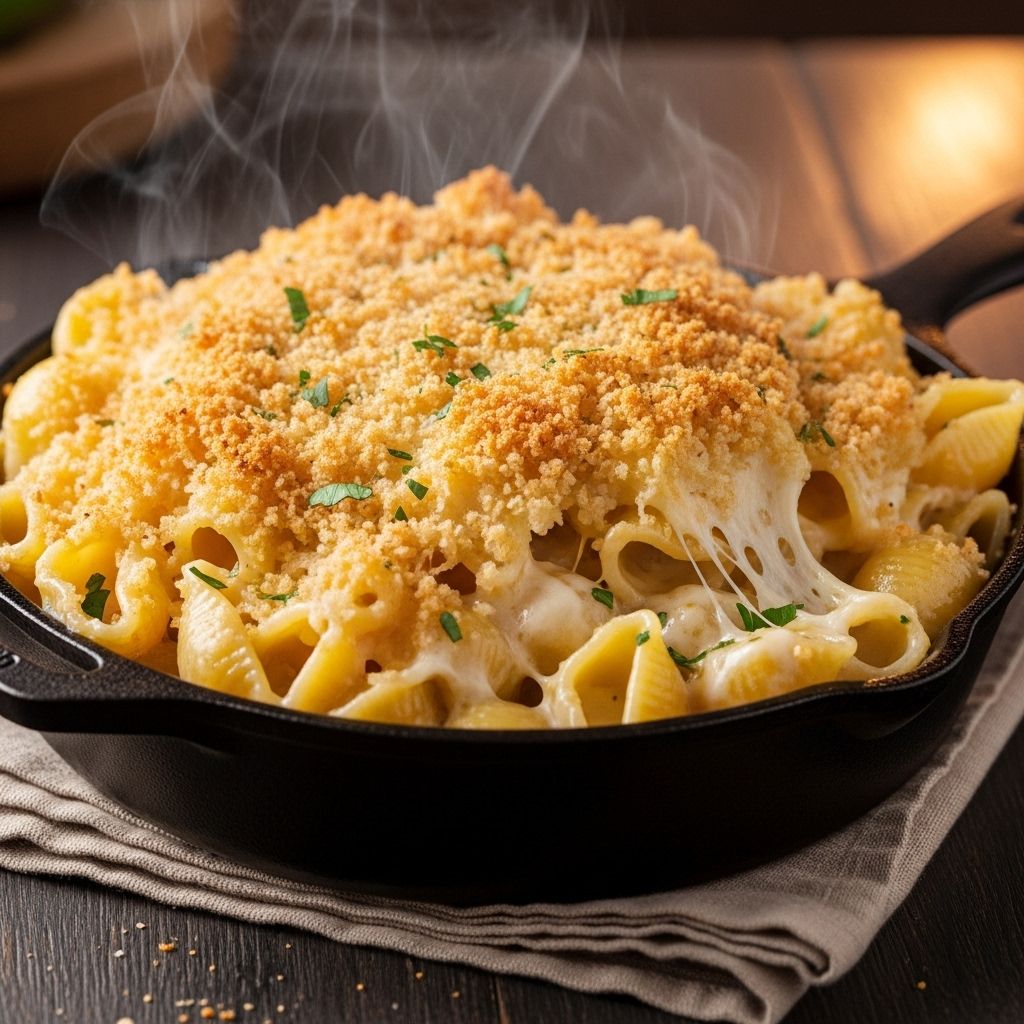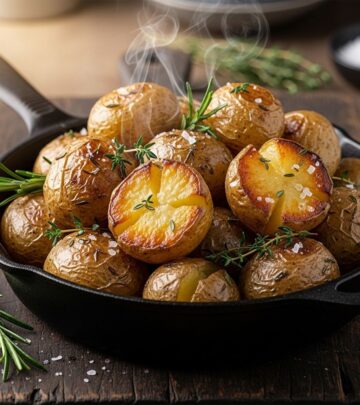Baked Mac And Cheese Recipe: Tips For Creamy, Crispy Perfection
Master the art of creating the creamiest, cheesiest, most flavorful baked mac and cheese from scratch

Image: HearthJunction Design Team
The Ultimate Guide to Homemade Baked Mac and Cheese
There’s nothing quite like a warm, bubbling dish of baked mac and cheese fresh from the oven. This classic comfort food has earned its place as a beloved staple on dinner tables across America, and for good reason. When made properly, homemade mac and cheese delivers a perfect balance of creamy, cheesy sauce and tender pasta, topped with a crispy, golden crust that makes every bite memorable.
Unlike the boxed varieties, a homemade baked mac and cheese offers rich, complex flavors and textures that simply can’t be replicated with powdered cheese packets. Today, we’re sharing our comprehensive guide to creating the ultimate baked mac and cheese that will have everyone asking for seconds.
Why This Recipe Works
This baked mac and cheese recipe stands apart from others for several important reasons:
- It uses a carefully balanced combination of cheeses for optimal flavor and texture
- The sauce incorporates a proper roux for stability and creaminess
- The pasta is slightly undercooked before baking to prevent mushiness
- The breadcrumb topping adds the perfect contrasting texture
- Each component is seasoned perfectly for a well-rounded flavor profile
Whether you’re preparing this for a weeknight family dinner, bringing it to a potluck, or serving it as a holiday side dish, this recipe delivers consistently excellent results that will impress even the most discerning mac and cheese connoisseurs.
Ingredients You’ll Need
For the Pasta
The foundation of any great mac and cheese starts with the right pasta. While elbow macaroni is traditional, other short pasta shapes like cavatappi, shells, or farfalle work beautifully as well. The key is choosing a shape with nooks and crannies that will hold the cheese sauce effectively.
- 1 pound (16 oz) elbow macaroni or other short pasta
- 1 tablespoon salt (for the pasta water)
For the Cheese Sauce
The heart and soul of any mac and cheese is undoubtedly the cheese sauce. Our version uses a classic roux-based béchamel that’s enriched with a carefully selected blend of cheeses for the perfect balance of flavor and texture.
- 4 tablespoons unsalted butter
- 1/3 cup all-purpose flour
- 3 cups whole milk
- 1 cup heavy cream
- 4 cups shredded cheese blend (recommended: 2 cups sharp cheddar, 1 cup Gruyère, 1 cup fontina)
- 1 teaspoon salt
- 1/2 teaspoon black pepper
- 1/4 teaspoon garlic powder
- 1/4 teaspoon mustard powder
- 1/8 teaspoon cayenne pepper (optional)
For the Topping
A crispy, golden topping provides the perfect textural contrast to the creamy pasta beneath. Our topping combines buttery breadcrumbs with a touch of additional cheese for that perfect finish.
- 1 cup panko breadcrumbs
- 2 tablespoons melted butter
- 1/2 cup shredded sharp cheddar cheese
- 1 tablespoon fresh parsley, finely chopped (optional)
- 1/4 teaspoon paprika (optional)
Equipment Needed
Before you begin, gather these essential tools to ensure a smooth cooking process:
- Large pot for boiling pasta
- Colander for draining
- Heavy-bottomed saucepan or Dutch oven for the cheese sauce
- Whisk
- Wooden spoon or silicone spatula
- 9×13 inch baking dish
- Measuring cups and spoons
- Box grater (if shredding your own cheese)
- Small bowl for mixing topping ingredients
Step-by-Step Instructions
Preparing the Pasta
The first step in creating perfect baked mac and cheese is properly cooking the pasta. It’s crucial to slightly undercook the pasta since it will continue to cook in the oven.
1. Preheat your oven to 350°F (175°C) and lightly grease a 9×13 inch baking dish.
2. Bring a large pot of water to a rolling boil. Add 1 tablespoon of salt to the water – this is essential for flavoring the pasta from within.
3. Add the pasta to the boiling water and cook for about 2 minutes less than the package instructions indicate for al dente. The pasta should be slightly firmer than you’d normally prefer, as it will continue to soften while baking.
4. Drain the pasta in a colander, but do not rinse it. The starchy exterior helps the cheese sauce adhere better.
5. Return the pasta to the pot and toss with a small drizzle of olive oil to prevent sticking while you prepare the cheese sauce.
Making the Perfect Cheese Sauce
The cheese sauce is where the magic happens in mac and cheese. A proper roux-based sauce ensures a smooth, creamy texture without graininess or separation.
1. In a large, heavy-bottomed saucepan or Dutch oven, melt the butter over medium heat until foamy but not browned.
2. Add the flour to the melted butter and whisk continuously for about 1-2 minutes to cook out the raw flour taste. This mixture (called a roux) should be a pale golden color and smell slightly nutty.
3. Gradually add the milk and cream to the roux, whisking constantly to prevent lumps from forming. Start with about 1/2 cup, whisk until smooth, then continue adding the liquid gradually while whisking.
4. Bring the mixture to a gentle simmer, stirring frequently. The sauce will begin to thicken as it heats – this usually takes 5-7 minutes. You’ll know it’s ready when it coats the back of a spoon and a line drawn with your finger remains clear.
5. Remove the pan from heat and add the spices: salt, pepper, garlic powder, mustard powder, and cayenne (if using). Whisk to incorporate.
6. Add the shredded cheeses one handful at a time, stirring after each addition until fully melted and smooth before adding more. This gradual approach helps ensure a smooth, homogeneous sauce.
7. Taste the sauce and adjust seasonings if needed. Remember that the pasta will dilute the flavor slightly, so the sauce should be well-seasoned.
Assembling and Baking
Now comes the satisfying part – bringing everything together and creating that perfect baked dish with its signature golden top.
1. Add the cooked pasta to the cheese sauce, folding gently with a spatula until every piece is evenly coated. Be careful not to break the pasta.
2. Transfer the mac and cheese mixture to your prepared baking dish, spreading it evenly.
3. In a small bowl, combine the panko breadcrumbs and melted butter, mixing until the crumbs are evenly moistened. Stir in the additional shredded cheddar, chopped parsley, and paprika if using.
4. Sprinkle the breadcrumb mixture evenly over the top of the mac and cheese.
5. Bake in the preheated oven for 25-30 minutes, until the topping is golden brown and the edges are bubbling.
6. For an extra-golden topping, you can place the dish under the broiler for 1-2 minutes at the end of baking, but watch it carefully to prevent burning.
7. Remove from the oven and let stand for 5-10 minutes before serving. This resting period allows the sauce to set slightly, making it easier to serve.
Pro Tips for Mac and Cheese Success
Elevate your baked mac and cheese with these expert tips that make a noticeable difference:
- Grate your own cheese: Pre-shredded cheese contains anti-caking agents that can make your sauce grainy. For the smoothest texture, buy blocks of cheese and grate them yourself.
- Bring ingredients to room temperature: Cold milk and cheese can cause the sauce to seize or become lumpy. Let them sit out for 30 minutes before cooking.
- Don’t skimp on fat content: Whole milk and heavy cream create a silkier, more stable sauce than lower-fat alternatives.
- Season each component: Season the pasta water, the cheese sauce, and even the topping for layers of flavor.
- Create contrast: The textural difference between the creamy interior and crispy topping is what makes baked mac and cheese special.
Variations to Try
Once you’ve mastered the basic recipe, consider these delicious variations to keep things interesting:
Mix-In Ideas
- Protein additions: Fold in crispy bacon bits, diced ham, or shredded rotisserie chicken
- Vegetable options: Add sautéed mushrooms, caramelized onions, roasted broccoli, or peas
- Flavor boosters: Mix in sun-dried tomatoes, pesto, truffle oil, or roasted garlic
Cheese Combinations
While our recommended cheese blend provides excellent results, don’t be afraid to experiment with different combinations:
- Sharp white cheddar + smoked gouda: For a smoky, sophisticated flavor
- Monterey jack + pepper jack: For a mildly spicy Southwestern twist
- Fontina + parmesan + mozzarella: For an Italian-inspired variation
- Blue cheese + gruyère: For an intense, complex flavor profile (use blue cheese sparingly)
Make-Ahead and Storage Tips
Baked mac and cheese is perfect for make-ahead preparation and can be stored for later enjoyment:
Make-Ahead Options
1. Fully assembled, unbaked: Prepare the recipe up to the point of baking, cover tightly with foil, and refrigerate for up to 2 days. When ready to serve, bake as directed, adding 5-10 minutes to the cooking time.
2. Cheese sauce only: Prepare just the cheese sauce up to 3 days ahead, store refrigerated in an airtight container, and rewarm gently before combining with freshly cooked pasta.
Storage Guidelines
1. Refrigerating leftovers: Store cooled leftovers in an airtight container for up to 4 days.
2. Freezing: While the texture isn’t quite as perfect after freezing, you can freeze baked mac and cheese in portions for up to 2 months. Thaw overnight in the refrigerator before reheating.
Reheating Methods
1. Oven (best method): Cover with foil and bake at 350°F for 20-30 minutes until heated through. Remove foil for the last 5 minutes to re-crisp the top.
2. Microwave: For individual portions, microwave on 50% power, stirring occasionally, until heated through.
3. Stovetop: Reheat gently in a saucepan over low heat, adding a splash of milk to revive the creaminess.
Why Homemade Beats Boxed Every Time
While the convenience of boxed mac and cheese is undeniable, the homemade version offers numerous advantages:
- Superior flavor: Real cheese creates depth of flavor that powdered cheese simply cannot match
- Customizable: Adjust cheese types, seasonings, and add-ins to suit your preferences
- Better texture: Achieve that perfect balance of creamy sauce and al dente pasta
- No artificial ingredients: Control exactly what goes into your meal
- Impressive presentation: A golden-topped baking dish of mac and cheese makes a statement that no box ever could
Frequently Asked Questions
Q: Why is my mac and cheese grainy instead of smooth?
A: Graininess usually comes from overheating the cheese or using pre-shredded cheese with anti-caking agents. Always remove the sauce from heat before adding cheese, add it gradually, and consider grating your own cheese for best results.
Q: Can I make this recipe gluten-free?
A: Yes! Substitute gluten-free pasta and use a gluten-free flour blend for the roux. Rice flour works particularly well for gluten-free cheese sauces.
Q: Why undercook the pasta before baking?
A: Pasta continues to cook in the oven as it absorbs moisture from the sauce. Starting with slightly undercooked pasta ensures it will be perfectly al dente when the dish is finished baking, not mushy.
Q: Can I skip the roux and just melt cheese into milk?
A: While you can make mac and cheese without a roux, the flour-based roux provides stability to the sauce and prevents the cheese from separating during baking. For the best texture and consistency, we recommend using the roux method.
Q: What’s the best cheese for mac and cheese?
A: The ideal mac and cheese uses a combination of cheeses: sharp cheddar for flavor, and a meltable cheese like Gruyère, fontina, or Monterey Jack for creaminess. American cheese, while not fancy, contains sodium citrate that helps create a smooth sauce.
References
Read full bio of Anjali Sayee












